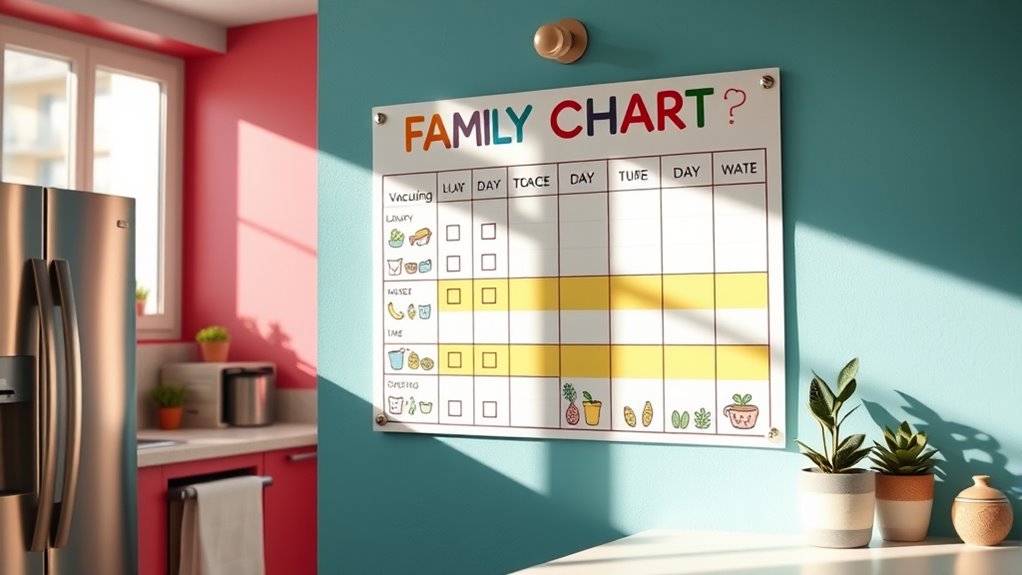To create a smart family chore chart, start by evaluating your household’s unique needs and routines. Choose a format that suits your family’s tech comfort, like digital or printable charts, and assign age-appropriate tasks with clear instructions. Keep the plan flexible for busy days and involve everyone in its development. Establish consistent routines, track progress with visual tools, and encourage involvement for ownership. Keep exploring to discover how these strategies can make chores easier and more effective.
Key Takeaways
- Assess household needs, assign age-appropriate chores, and communicate clearly using visual tools for accountability.
- Choose a suitable chore chart format—digital, printable, or visual—to match family preferences and tech comfort.
- Design flexible, adaptable chores based on members’ availability, incorporating backups and rotation to prevent burnout.
- Use visual motivators like stickers and rewards, establish routines, and provide positive feedback to sustain engagement.
- Involve all family members in creating and updating the chart, fostering ownership, teamwork, and adaptable responsibility sharing.
Assessing Your Household’s Unique Needs
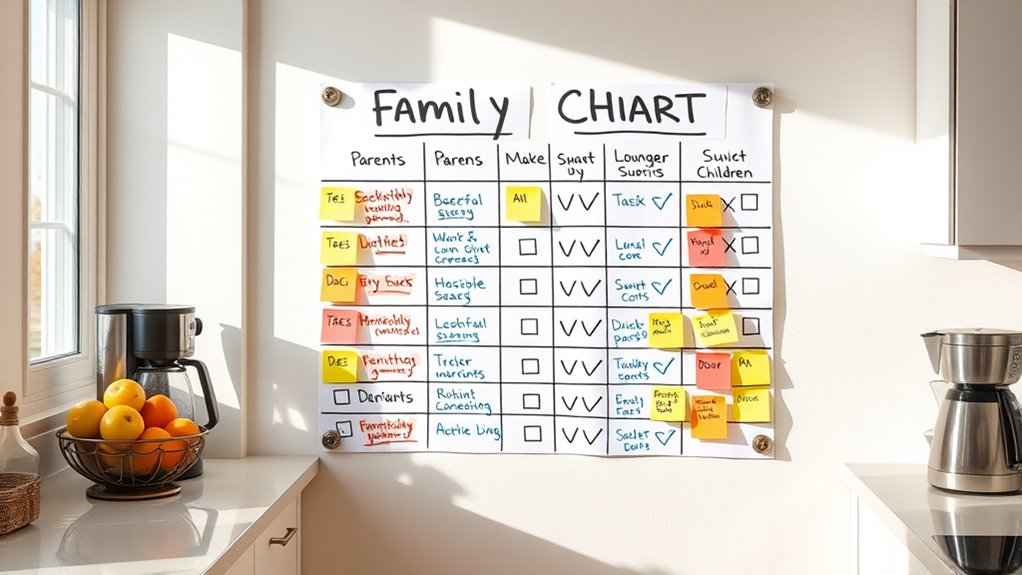
Before creating a chore chart, it’s essential to understand your household’s specific needs. Your household dynamics—such as the number of members, ages, and daily routines—play a big role in shaping an effective plan. Consider who’s available for chores and how much time each person can dedicate. Chore customization is key; tasks should suit individual abilities and preferences to encourage participation. Observe how chores are currently managed and identify gaps or overlaps. Think about special circumstances, like work schedules or school commitments, that might influence chore assignments. Additionally, understanding each family member’s responsibilities and how they impact daily workflows can help in designing a balanced chore system. By evaluating these factors, you’ll create a tailored approach that promotes fairness and efficiency, ensuring everyone contributes without feeling overwhelmed. This understanding lays a strong foundation for a successful family chore chart.
Choosing the Right Chore Chart Format
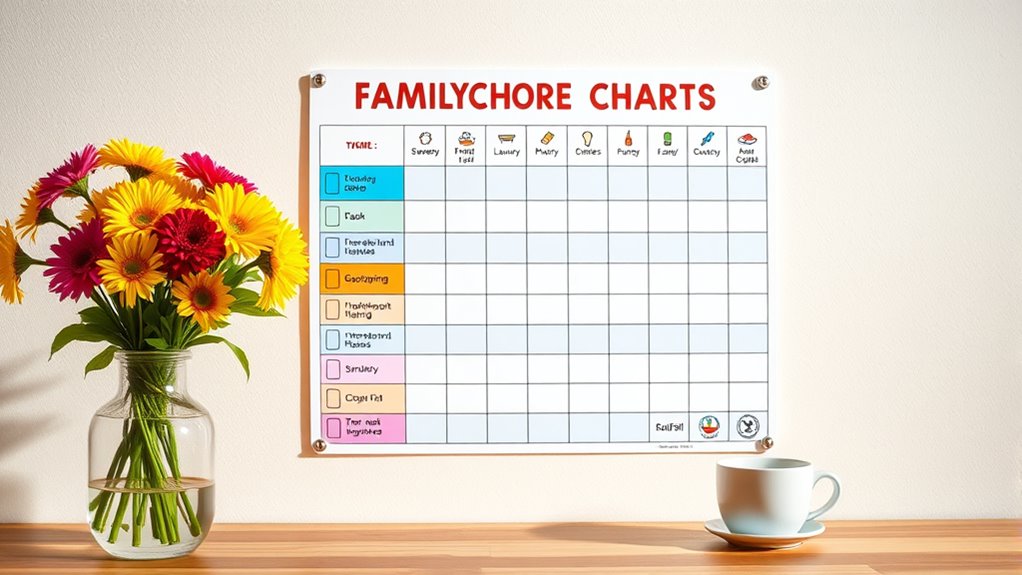
Selecting the right chore chart format is essential to ensuring your household stays organized and motivated. You have options like using digital tools, printable templates, or even a simple paper chart. Digital tools offer convenience, automatic reminders, and easy updates for busy families. Printable templates provide a customizable, cost-effective way to tailor chores to your household’s needs. Think about your family’s tech comfort level and how visual or tactile you want the chart to be. Additionally, considering the user experience with different projectors can help you choose the best display method for your needs. Here are some options to consider:
- Digital apps with interactive features
- Printable templates for DIY customization
- Magnetic or whiteboard charts for easy updates
- Simple paper charts for quick setup
Choosing the right format keeps everyone engaged and makes chores feel manageable.
Assigning Age-Appropriate Tasks
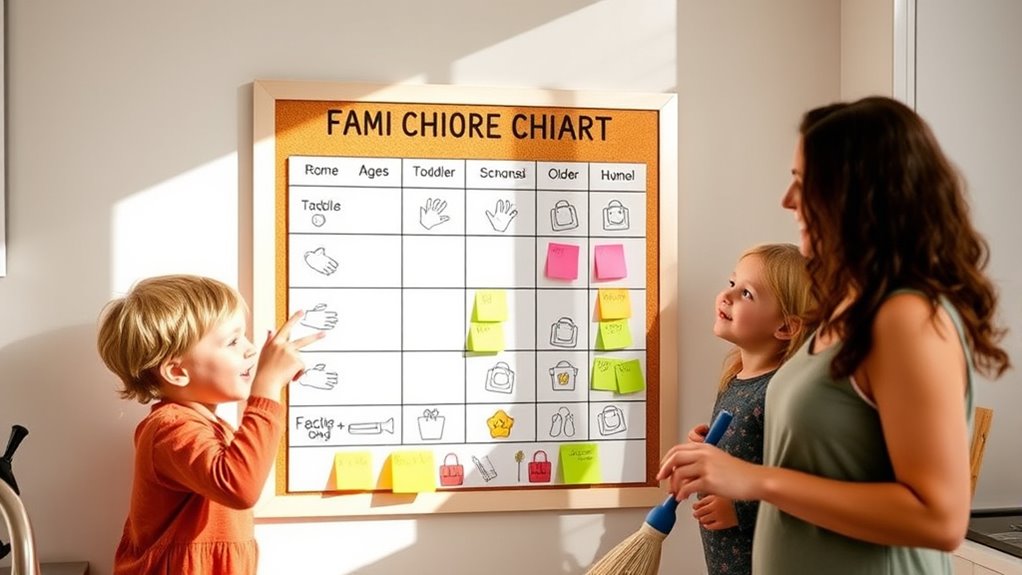
You should choose tasks that match your child’s age and abilities to keep them engaged and successful. As they grow, gradually increase their responsibilities to build confidence and independence. This approach guarantees chores remain appropriate and help your kid develop new skills over time. Incorporating personal touches such as family heirlooms or travel souvenirs can also make chores more meaningful and enjoyable for children.
Age-based Task Selection
How can you guarantee that chores are both manageable and effective for your children? The key is selecting age-based, skill-based tasks that match their development level. For younger kids, simple, hands-on chores like dusting or watering plants work well. As they grow, introduce tasks that require more coordination, such as sorting laundry or setting the table. Older children can handle more responsibility, like vacuuming or preparing snacks. Keep in mind:
- Tasks should be age appropriate and within their skill level
- Break complex chores into smaller steps
- Offer clear instructions and demonstrations
- Adjust tasks as they develop new skills
- Monitoring their progress is essential, especially if they are using digital literacy programs to enhance their communication skills.
Gradual Responsibility Increase
Building on age-appropriate task selection, gradually increasing your child’s responsibilities helps them build confidence and develop new skills. Using motivation strategies, like praise or small rewards, encourages them to embrace new chores. Rotating chores regularly prevents boredom and broadens their skill set. Consider this chore rotation table:
| Chore Type | Rotation Frequency |
|---|---|
| Basic Tasks | Weekly |
| Skill-Building | Bi-weekly |
| Creative Chores | Monthly |
| Responsibility Level | Gradually Increase |
| Motivation Strategies | Consistent Use |
This approach keeps chores fresh and engaging, allowing your child to master tasks at a comfortable pace. It also reinforces the idea that responsibilities evolve, fostering independence and accountability over time. Incorporating diverse designs in chore charts can make the process more appealing and motivating for children.
Establishing Clear Expectations and Responsibilities
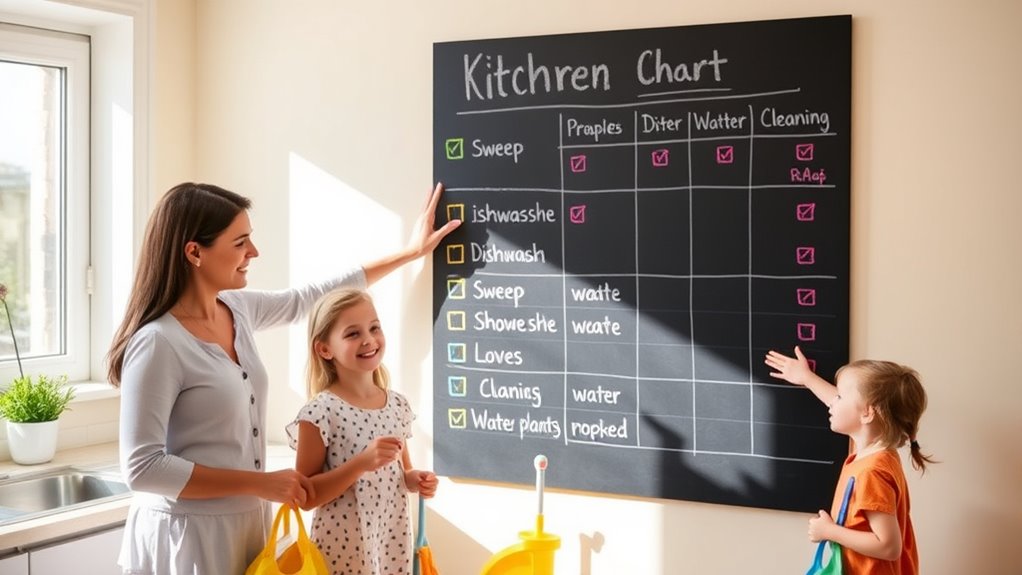
Clear expectations and responsibilities are the foundation of an effective family chore chart. When everyone understands their roles, household communication improves, and chore accountability increases. To set this up, clearly define each task and assign it to specific family members. Use simple language so everyone knows what’s expected. Make sure responsibilities are fair and age-appropriate. Keep open lines of communication so questions and concerns are addressed quickly. Consider creating a visual chart or checklist to reinforce clarity. Regularly review and update responsibilities as needed to prevent confusion. When everyone knows exactly what’s expected, chores become less of a battle and more of a team effort. Clear expectations foster cooperation and help your family work together smoothly. Being attentive to relationship dynamics can also help identify and address underlying issues that may affect household harmony.
Incorporating Flexibility for Busy Schedules

When your schedule gets hectic, it’s important to have adaptable task assignments and flexible time slots to keep chores manageable. You should also create emergency backup plans so chores don’t fall behind if unexpected situations arise. This approach helps your family stay on track without added stress. Incorporating multiplayer options from arcade gaming can inspire collaborative chore efforts and motivate family members.
Adaptable Task Assignments
To accommodate busy family schedules, it’s essential to create chore charts that are flexible and adaptable. This means you should focus on task delegation and chore rotation to prevent burnout and keep things fair. Assign tasks based on each person’s availability and strengths, but be ready to switch things up when needed. Keep the chore list dynamic, allowing adjustments without stress. This approach encourages shared responsibility and prevents resentment. You might also set up a system where chores are assigned temporarily, then rotated regularly. Flexibility ensures that everyone can handle their responsibilities without feeling overwhelmed, making chores feel less like a burden and more like a team effort. Incorporating adjustable settings into your chore system can help accommodate unforeseen schedule changes and keep everyone engaged.
Flexible Time Slots
Flexible time slots make chore charts more practical for busy families. By allowing you to adjust chore scheduling around your hectic schedule, you improve overall time management. Instead of rigid deadlines, you can assign chores to specific windows, giving family members the freedom to complete tasks when it fits best. This approach reduces stress and increases accountability, as chores can be rescheduled without guilt. Incorporate flexible time slots by setting broad time frames—like morning or evening—and let family members choose when to tackle their chores within those periods. This adaptability makes it easier to handle unexpected events or busy days, ensuring chores are completed without disrupting everyone’s plans. Additionally, using Pimple Patches as a metaphor for targeted, effective action can remind families to focus on specific chores at the right time, reinforcing the importance of strategic scheduling. Ultimately, flexible chore scheduling keeps your family organized while respecting individual schedules.
Emergency Backup Plans
Emergency backup plans are essential for maintaining household order when unexpected events disrupt your family’s routine. Flexibility in your backup planning guarantees you can adapt quickly, especially during busy schedules. Prepare for emergencies by having a clear plan in place for sudden changes, like illness or last-minute commitments. Keep these strategies in mind:
- Assign a secondary person to handle chores if the primary is unavailable
- Create a list of quick, manageable tasks for days with limited time
- Store essential supplies in an accessible location for emergencies
- Communicate backup plans regularly so everyone knows their roles
- Incorporate privacy and cookie management to ensure your household’s online safety and communication security during emergencies
Using Visuals and Rewards to Motivate

Have you ever noticed how visuals and rewards can make chores feel more manageable and fun? Using visual motivation, like colorful charts or stickers, helps kids see their progress clearly. Reward systems, such as earning small prizes or privileges, encourage consistency and effort. When kids see their achievements visually, they’re more motivated to complete tasks without nagging. Incorporate charts that track chores with symbols or pictures to make them engaging. Offering rewards for reaching milestones reinforces positive behavior and builds confidence. Keep rewards simple and meaningful—like extra screen time or a favorite treat—to maintain motivation. Combining visual cues with a clear reward system turns chores into a game, making participation more appealing for everyone. Minimalist design principles can also help keep the chore system uncluttered and easy to understand.
Implementing a Consistent Routine
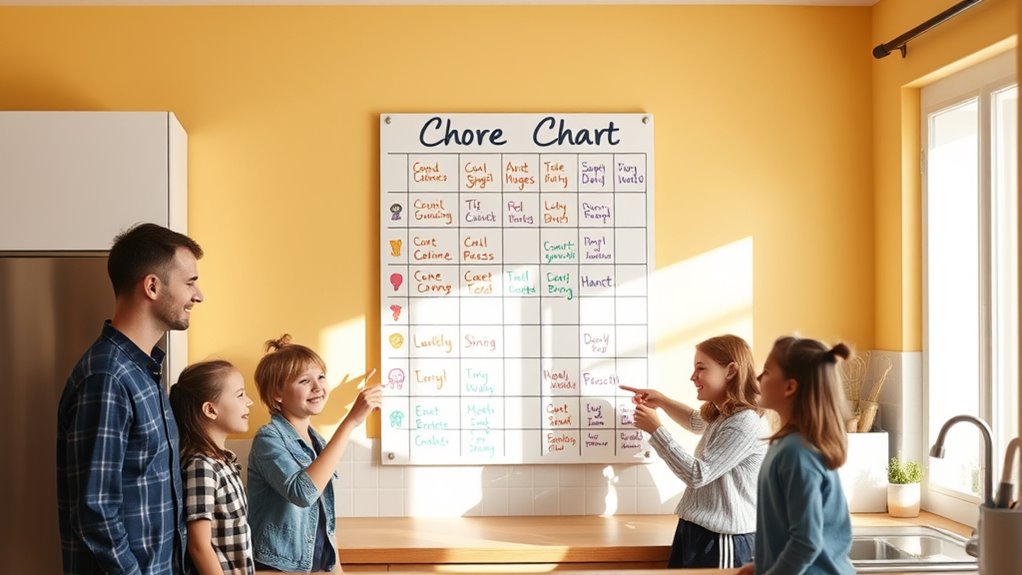
Establishing a consistent routine is essential for helping kids understand what to expect and when to do their chores. Consistency creates a sense of stability and reduces resistance. To keep motivation high, use motivational techniques like praise or small rewards when chores are completed on time. Customize your chore chart to fit your family’s schedule, making it easier for everyone to follow. Incorporating structured routines can further enhance adherence and make chores feel more manageable.
Tracking Progress and Providing Feedback
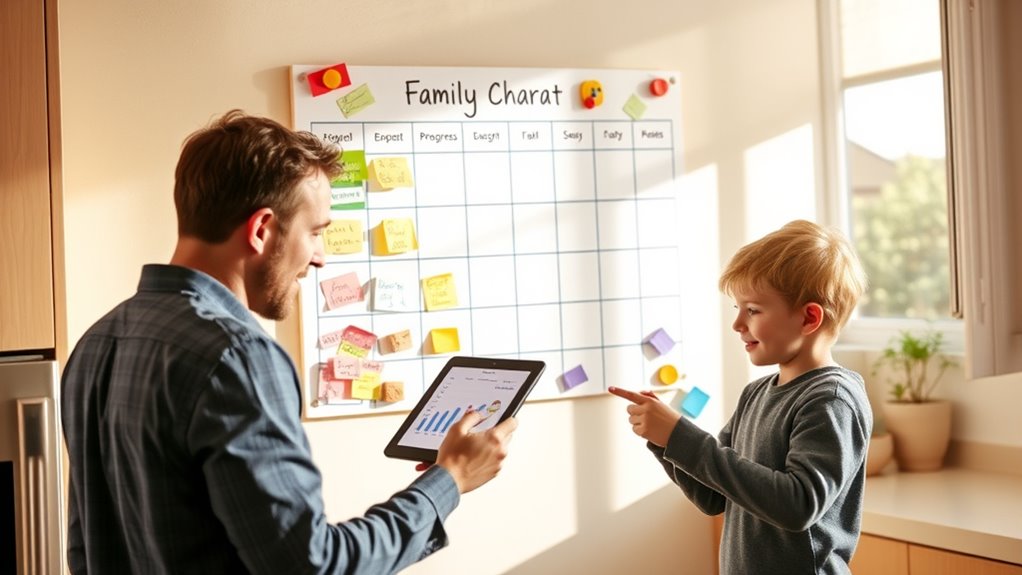
Once your family has a routine in place, tracking progress becomes the next step to keep everyone motivated. Regular progress monitoring helps you see how well chores are being completed and highlights areas needing improvement. Use simple feedback methods like praise, encouragement, or a quick family check-in to reinforce positive behavior. Celebrate small wins to boost motivation and keep chores engaging. Consider visual tools like charts or stickers to make progress visible and tangible. Providing timely feedback ensures family members understand their efforts are valued and understood. Avoid waiting too long to address issues—prompt, constructive feedback helps everyone stay on track. Incorporating churning techniques and understanding the importance of consistency can also motivate family members to maintain their responsibilities. By actively tracking progress and offering encouragement, you’ll foster accountability and a sense of achievement within your family routine.
Adjusting the Chart as Your Family Grows
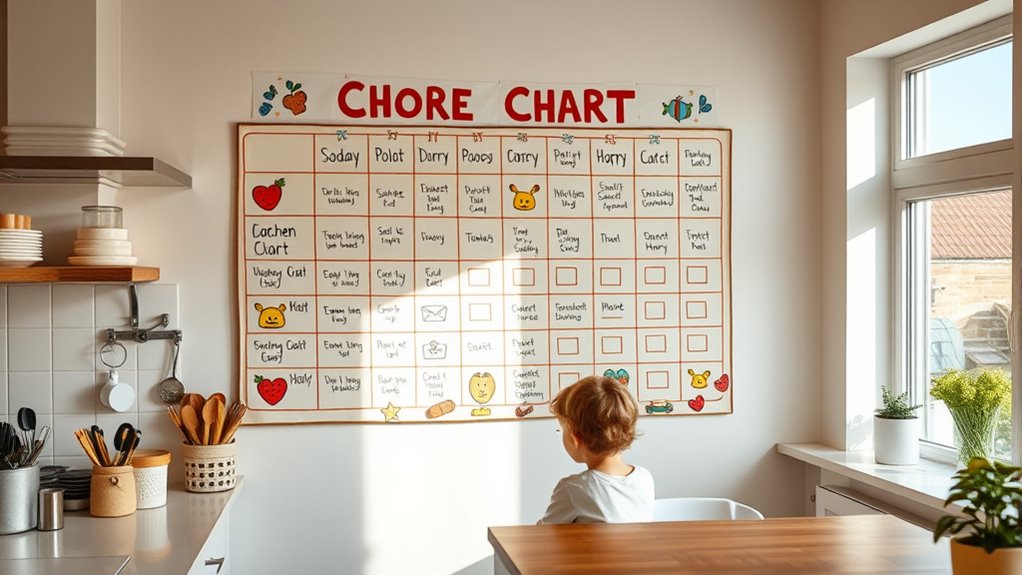
As your family grows and routines change, it’s important to update the chore chart to reflect new responsibilities and schedules. With a nursery in the picture, you might need to assign tasks like nursery organization or diaper changing duties. As children get older, they can take on pet care responsibilities, such as feeding or walking the dog. To keep everyone accountable, revisit the chart regularly and adjust assignments as needed. Consider adding new chores for older kids or shifting responsibilities to balance workload. Keep communication open so everyone understands their new roles. This way, your chore chart stays relevant and helps your family smoothly adapt to your evolving household. Flexibility is key to making sure chores match your family’s current needs.
Encouraging Family Involvement and Ownership
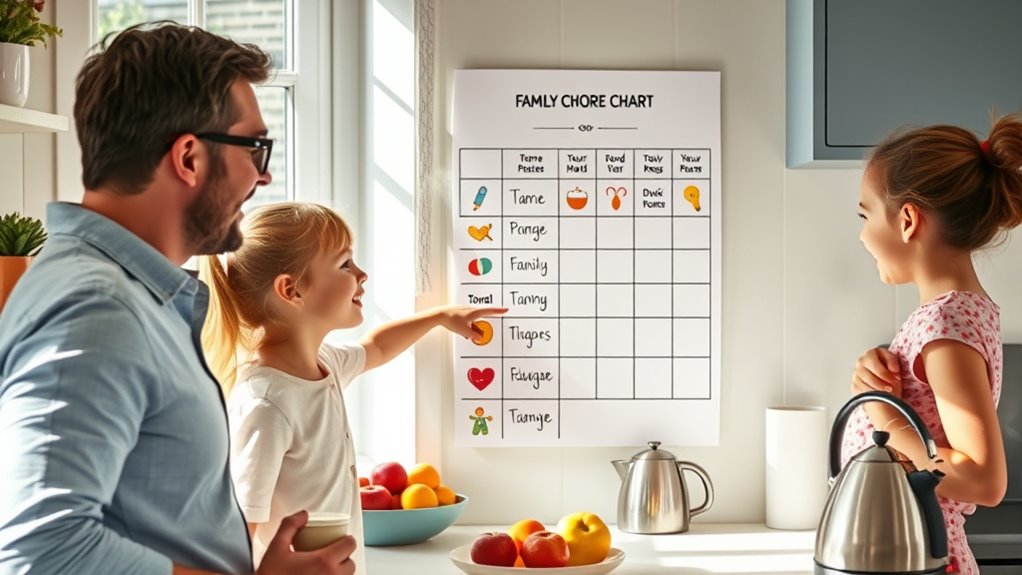
Encouraging family involvement and ownership starts by giving everyone a sense of responsibility and making them feel valued. When each family member takes part in creating and maintaining the chore chart, it boosts family motivation and cultivates a sense of teamwork. Reinforcing a chore tradition helps children see chores as a shared family effort rather than a burden. To foster ownership, involve everyone in choosing tasks and setting expectations, making chores feel meaningful rather than imposed. Celebrate small wins and acknowledge contributions to reinforce positive behavior. When family members feel they have a voice and their efforts matter, they’re more likely to stay committed. Incorporating consistent routines can further solidify the habit of completing chores and promote stability within the household. This approach builds a supportive environment where chores become a natural part of family life, strengthening bonds and establishing lasting routines.
Frequently Asked Questions
How Can I Make Chores Fun for My Children?
To make chores fun for your children, use creative incentives like small rewards or praise to motivate them. Turn chores into a game by creating a chore station where they can earn points or stickers for completing tasks. You can also set timers or play music to make the process lively and engaging. These strategies keep chores enjoyable and encourage kids to participate willingly.
What Are Signs My Chore Chart Isn’T Working?
Think of your chore chart as a garden; if weeds appear or plants wilt, it signals issues. You’ll notice household communication slipping or chores becoming inconsistent, meaning the system isn’t working. Signs include children ignoring tasks, frustration growing, or routines breaking down. When these happen, it’s time to tend the garden—revisit your expectations, reinforce communication, and restore chore consistency to help your family thrive again.
How Do I Handle Chores for Reluctant or Resistant Kids?
When dealing with reluctant kids, try using motivational strategies like praise and rewards to boost their enthusiasm. Make sure chores are age-appropriate tasks to prevent frustration and build confidence. Make chores fun by turning them into games or challenges, and involve your kids in choosing their responsibilities. Consistency and positive reinforcement help establish good habits, gradually reducing resistance and fostering a sense of responsibility and pride in completing their chores.
Should Chores Be Paid or Unpaid?
You might think chores should always be unpaid, but introducing monetary incentives or chore rewards can motivate reluctant kids. Paying for chores helps them understand the value of money and builds responsibility. While unpaid chores foster intrinsic motivation, offering rewards can boost participation and make chores feel more rewarding. Ultimately, mixing both approaches can create a balanced system that encourages effort and teaches valuable life skills.
How Can I Prevent Chores From Becoming a Source of Conflict?
To prevent chores from causing conflict, establish clear communication strategies by discussing expectations openly and listening to everyone’s concerns. Use reward systems to motivate participation and acknowledge effort, which helps reduce resentment. Consistently enforce rules and offer positive reinforcement. By fostering respect and understanding, you create a cooperative environment where chores feel less like a burden and more like a shared responsibility.
Conclusion
Creating a family chore chart isn’t about adding stress—it’s about fostering responsibility and teamwork. You might worry it’ll feel like a chore itself, but with the right plan, it becomes a helpful tool that brings your family closer. Stay flexible, celebrate small wins, and remember that consistency wins over perfection. Soon, everyone will see chores as part of your family’s shared journey, making daily routines smoother and more enjoyable for all.

